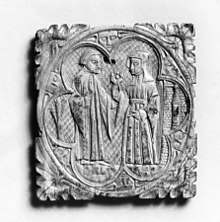Hexafoil

A hexafoil is a traditional element of Gothic architecture,[1] created by overlapping six circular arcs to form a flower-like image.[2][3]
One common form of the hexafoil has a ring of six tangent circles circumscribed by a larger circle. It may be constructed by compass and straightedge, by drawing six circles at the centers of a regular hexagon, with diameter equal to the side of the hexagon.[4] The inner circles of the hexafoil have radius 1/3 that of the outer circle containing them, from which it is possible to derive the area and perimeter of the figure as a mathematical exercise.[5]
References
- ^ Hartop, Christopher; Norton, Jonathan (2008), Geometry and the silversmith: the Domcha Collection, John Adamson, ISBN 9780952432289,
The trefoil, quatrefoil, hexafoil and octofoil, essential elements of Gothic architecture, all figure in medieval silver.
- ^ Passmore, Augustine C. (1904), Handbook of Technical Terms Used in Architecture and Building and Their Allied Trades and Subjects, Scott, Greenwood, and Company, p. 178,
A geometrical figure used in tracery ; it is composed of six lobes or parts of circles joining each other.
- ^ Rugoff, Milton (1976), The Britannica encyclopedia of American art: a special educational supplement to the Encyclopaedia Britannica, Encyclopaedia Britannica Educational Corp., p. 636,
A geometrical figure with six lobes, used as the form of a silver platter or a wooden decorative panel.
- ^ Spanton, John Humphrey (1895), Science and Art Drawing: Complete Geometrical Course ; Consisting of Plane and Solid Geometry, Orthographic and Isometric Projection, Projection of Shadow's the Principles of Map Projection, Graphic Arithmetic and Graphic Statics, Macmillan, p. 56.
- ^ Betz, William; Webb, Harrison Emmett; Smith, Percey Franklyn (1912), Plane Geometry, Mathematical texts for school, Ginn, p. 321.
